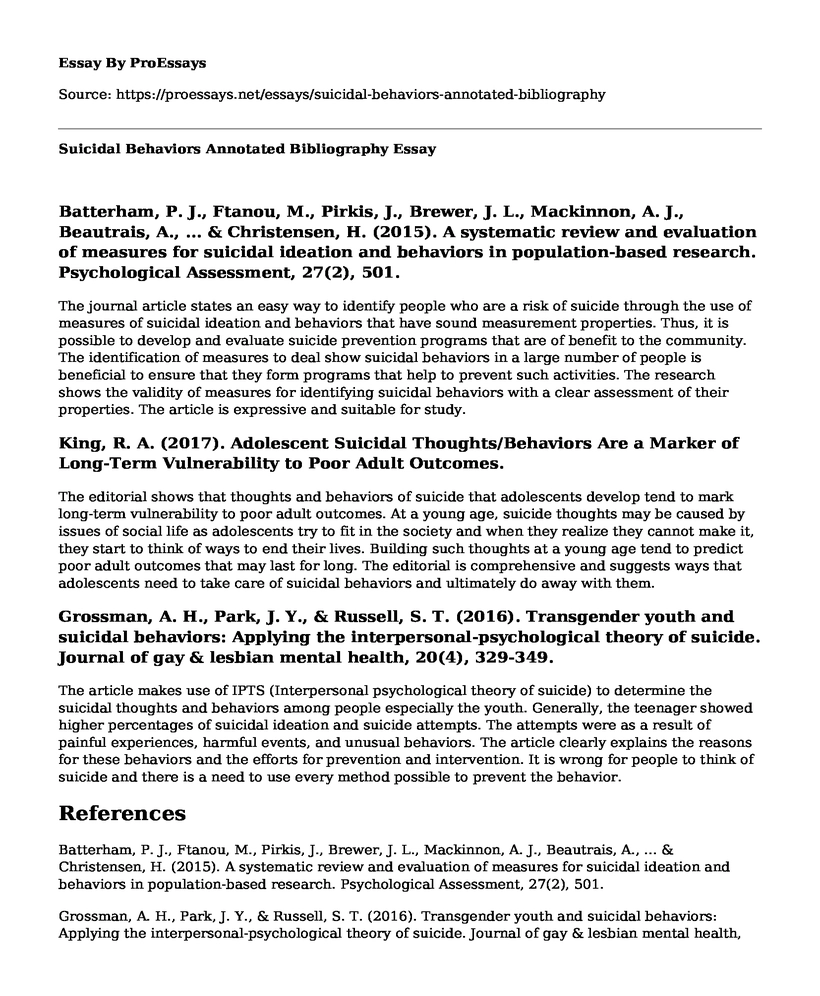Batterham, P. J., Ftanou, M., Pirkis, J., Brewer, J. L., Mackinnon, A. J., Beautrais, A., ... & Christensen, H. (2015). A systematic review and evaluation of measures for suicidal ideation and behaviors in population-based research. Psychological Assessment, 27(2), 501.
The journal article states an easy way to identify people who are a risk of suicide through the use of measures of suicidal ideation and behaviors that have sound measurement properties. Thus, it is possible to develop and evaluate suicide prevention programs that are of benefit to the community. The identification of measures to deal show suicidal behaviors in a large number of people is beneficial to ensure that they form programs that help to prevent such activities. The research shows the validity of measures for identifying suicidal behaviors with a clear assessment of their properties. The article is expressive and suitable for study.
King, R. A. (2017). Adolescent Suicidal Thoughts/Behaviors Are a Marker of Long-Term Vulnerability to Poor Adult Outcomes.
The editorial shows that thoughts and behaviors of suicide that adolescents develop tend to mark long-term vulnerability to poor adult outcomes. At a young age, suicide thoughts may be caused by issues of social life as adolescents try to fit in the society and when they realize they cannot make it, they start to think of ways to end their lives. Building such thoughts at a young age tend to predict poor adult outcomes that may last for long. The editorial is comprehensive and suggests ways that adolescents need to take care of suicidal behaviors and ultimately do away with them.
Grossman, A. H., Park, J. Y., & Russell, S. T. (2016). Transgender youth and suicidal behaviors: Applying the interpersonal-psychological theory of suicide. Journal of gay & lesbian mental health, 20(4), 329-349.
The article makes use of IPTS (Interpersonal psychological theory of suicide) to determine the suicidal thoughts and behaviors among people especially the youth. Generally, the teenager showed higher percentages of suicidal ideation and suicide attempts. The attempts were as a result of painful experiences, harmful events, and unusual behaviors. The article clearly explains the reasons for these behaviors and the efforts for prevention and intervention. It is wrong for people to think of suicide and there is a need to use every method possible to prevent the behavior.
References
Batterham, P. J., Ftanou, M., Pirkis, J., Brewer, J. L., Mackinnon, A. J., Beautrais, A., ... & Christensen, H. (2015). A systematic review and evaluation of measures for suicidal ideation and behaviors in population-based research. Psychological Assessment, 27(2), 501.
Grossman, A. H., Park, J. Y., & Russell, S. T. (2016). Transgender youth and suicidal behaviors: Applying the interpersonal-psychological theory of suicide. Journal of gay & lesbian mental health, 20(4), 329-349.
King, R. A. (2017). Adolescent Suicidal Thoughts/Behaviors Are a Marker of Long-Term Vulnerability to Poor Adult Outcomes.
Cite this page
Suicidal Behaviors Annotated Bibliography. (2022, Sep 11). Retrieved from https://proessays.net/essays/suicidal-behaviors-annotated-bibliography
If you are the original author of this essay and no longer wish to have it published on the ProEssays website, please click below to request its removal:
- Which Areas of Organizational Behavior Can Help You Understand what Greene Is Going Through?
- Research Paper on Sociopathic Personalities
- Essay Sample on the Play Therapy
- Social Work in Reducing Recidivism Paper Example
- Research Paper on Relational Aggression
- Unraveling the Mystery of Creativity: Beyond Logic & Imagination - Essay Sample
- Mental Health: Comp. Study of Players vs Non-Players - Essay Sample







